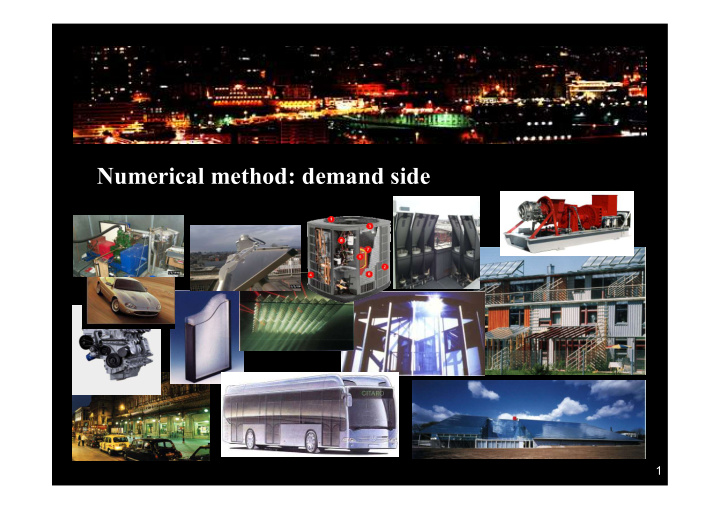



Numerical method: demand side 1
Target domains Systems Building Technical integration 2
Target domains Discretised system The rate of increase of φ within a fluid element = the rate of increase of φ due to diffusion - the net rate of flow of φ out of the element + the rate of increase of φ due to sources. contaminants electricity Whole system conservation statement formulated and solved at conduction successive time steps at an appropriate spatial resolution. heat convection physical properties & state control advection variables shortwave momentum radiation longwave other? mass radiation It is hubristic to suggest that the future can be predicted, only emulated to ensure resilience.
High resolution commercial building models Renewable energy Occupants Electrical network Form & content Control systems HVAC systems Lighting systems
Taylor series expansion: PDE approximation Add eqns: Subtract eqns: Truncate eqn 1: Central difference approximations First forward difference approx. Truncate eqn 2: First backward difference approx. 5
Fourier conduction eqn. Explicit formulation (central and first forward) Implicit formulation (central and first backward) W < 0.5 explicit Weighted average scheme W >= 0.5 implicit 6
Application issues Complications to differencing by Taylor series expansion: simultaneous presence of multiple heat transfer processes; time and positional dependency of heat generation due to solar radiation, mechanical plant etc.; discretisation leading to non-homogeneous, anisotropic finite volumes; presence of multi-dimensional effects. Alternative approach: directly apply conservation principles to small control volumes. 7
Control volume method – heat balance Heat flux: in the limit Heat storage: Energy balance: General form: Always the same! Note: equation can be applied to building and plant components; number of coefficients will vary; analogous considerations for mass and momentum balance. 8
Formulating a numerical model Continuous system made discrete by the placement of nodes at points of interest: nodes represent homogeneous or non- homogeneous physical volumes (comprising fluids, opaque and transparent surfaces, constructional elements, plant component parts, room contents etc. ). For each node, and in terms of all surrounding nodes representing regions deemed to be in thermodynamic contact, conservation equations are developed: represents the nodal condition and the inter-nodal transfers of energy, mass and momentum. The entire equation-set is solved simultaneously for successive time steps: gives the future time-row nodal state variables as a function of present time- row states and prevailing boundary conditions at both time-rows. 9
Modelling issues Not possible to prescribe a spatial discretisation scheme in advance ─ depending on the problem, model parts may require high resolution (many nodes) or low resolution (few nodes). Discretised conservation equations will have a variable number of coefficients depending on the node type. This will require a carefully designed matrix coefficient indexing scheme to facilitate efficient equation solution. Because different system parts will have different time constants and coupling strengths, equation processing must be structured to allow these effects to be reconciled whilst not enforcing a lowest common denominator processing frequency. Since different domain equations possess different characteristics (e.g. some are highly non-linear ─ an approach that depends on several co-operating solvers will be more computationally efficient than an approach that attempts to coerce the disparate equation-sets into a single solver type. 10
Numerical errors Two sources of error associated with finite differencing schemes: Rounding - where computations include an insufficient number of significant figures. Can be minimised by careful design of the numerical scheme and by operating in double precision. Discretisation - resulting from the replacement of derivatives by finite differences. Error minimised by reducing space and time increments. not possible to prescribe space and time increments because they depend on modelling objectives; implicit formulation attractive because it is unconditionally stable; discretisation depends on factors such as surface insolation, local convection, corner effects/thermal bridges, and the shape of the capacity/insulation system. 11
System discretisation By prescription: e.g. at least 3 nodes per homogeneous element with a time step less than 1 hour. Using thermal criteria: Biot Number << 1 use lumped parameter; else, equal thermal capacity divisions using the dwell time. Mixed node schemes often required. 12
Material energy conservation equation Material node types: opaque intra-construction; transparent intra-construction; phase change; boundary between elements; lumped. 13
Surface energy conservation equation Surface node types: room surfaces; plant component surfaces; ground. 14
Fluid energy conservation equation Surface node types: room air; construction air gaps; plant component fluids. 15
Equation structuring – building zone + contents + radiator outputs support: energy and comfort, impact of infiltration & ventilation, short- & longwave radiation, casual gains etc. 16
Equation structuring - passive/active solar system 17
Equation structuring - central heating system Outputs support: energy and comfort; building/plant zoning strategies; control, system efficiency, distribution losses etc. 18
Calculating equation coefficients Construction Conservation Equation Surface Conservation Equation Fluid Conservation Equation needs flow estimation needs radiation and convection estimation 19
Imposing control 20
Equation-set solution Equations are linked => simultaneous solution required. Equation-set is sparse and populated by clusters of equations relating to components with different time constants => special solver required to minimise the computational effort. Partitioning techniques often used allowing different clusters to be processed at different frequencies depending on the related time constant. This allows control decisions to be made, and problem parameters recomputed, more frequently for an item of plant requiring a computational time-step of, say, 1 minute, than for a heavyweight construction requiring, say, 60 minutes. Two main equation solving approaches: iterative and direct. 21
Equation-set extension Equation coefficients can be extended to improve the modelling resolution in relation to: short-wave and long-wave radiation; air movement; casual gains; surface convection; variation in fundamental parameters. 22
Technique can be similarly applied to all energy systems. 23
Recommend
More recommend